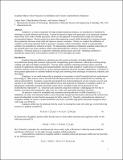Scandium Master Alloy Production Via Sulfidation and Vacuum Aluminothermic Reduction
Author(s)
Stinn, Caspar; Benderly-Kremen, Ethan; Allanore, Antoine
DownloadStinnAllanore_ScandiumTMS2023[7].pdf (2.266Mb)
Open Access Policy
Open Access Policy
Creative Commons Attribution-Noncommercial-Share Alike
Terms of use
Metadata
Show full item recordAbstract
Scandium is a critical component for high strength aluminum products, yet manufacture is burdened by
challenges in metal reduction and alloying. Current best practice begins with generation of an aluminum-scandium master alloy from oxide or halide precursors. However, this approach is characterized by high costs and large environmental impacts. Recent results have shown that employing a metal sulfide feedstock for aluminum master alloy production increases metal yield and improves process economics. Herein, we conduct the sulfidation of scandium oxide using elemental sulfur to generate a scandium sulfide intermediate, which we experimentally confirm to be amenable for reduction to metal. We demonstrate production of aluminum-scandium master alloy at the hundred-gram scale from scandium sulfide using aluminothermic reduction via reactive vacuum distillation. Chemical analysis is conducted to determine product purity and yield. Operating conditions to manufacture master alloys with scandium contents of 2 wt% and higher are tested.
Date issued
2023Department
Massachusetts Institute of Technology. Department of Materials Science and EngineeringPublisher
Springer Nature Switzerland
Citation
Stinn, C., Benderly-Kremen, E., Allanore, A. (2023). Scandium Master Alloy Production Via Sulfidation and Vacuum Aluminothermic Reduction. In: Broek, S. (eds) Light Metals 2023. TMS 2023. The Minerals, Metals & Materials Series. Springer, Cham.
Version: Author's final manuscript
ISSN
2367-1181
2367-1696
Collections
The following license files are associated with this item: